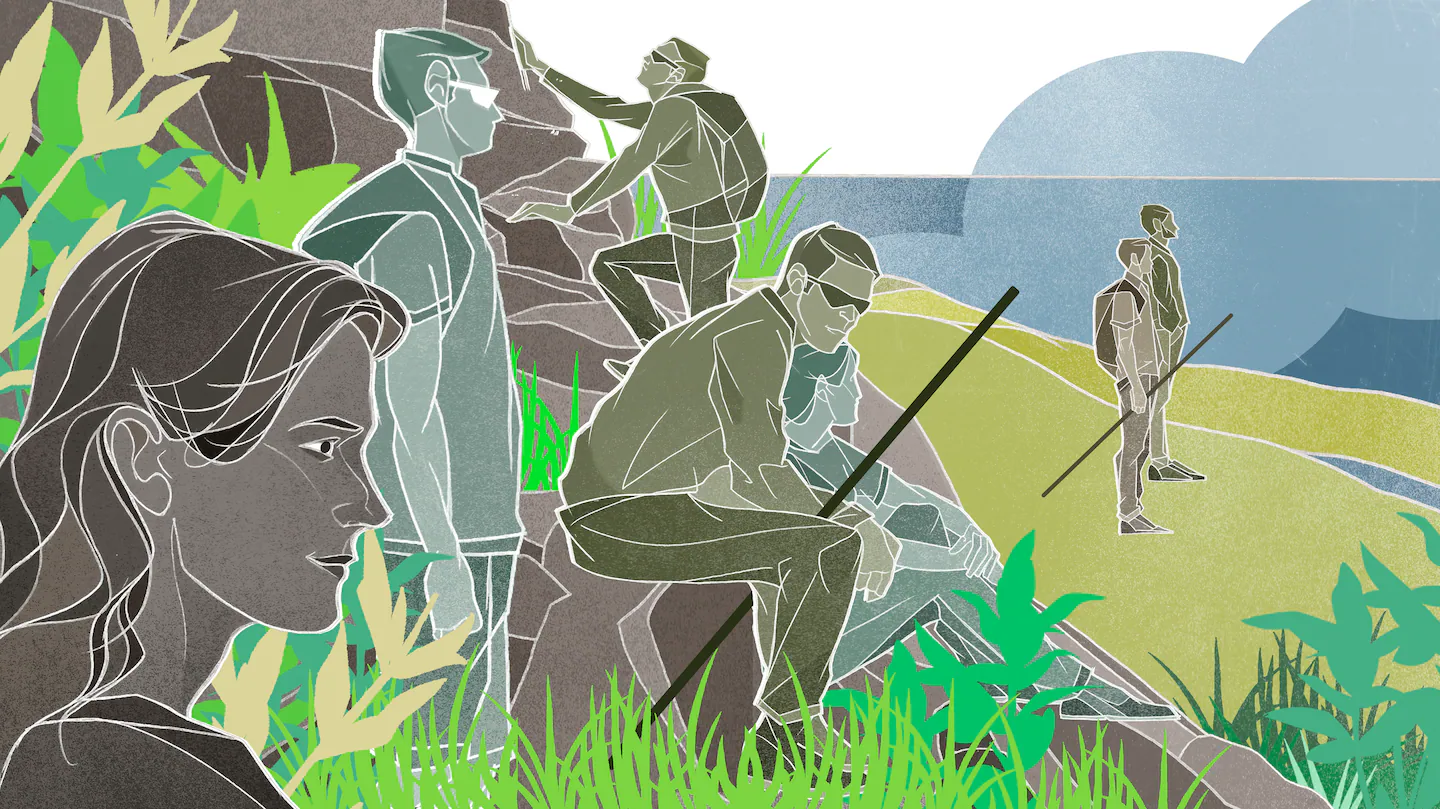
We ditched our car and hiked up the Beehive — a little mountain just outside Bar Harbor that boasts a stomach-churning trail to the summit with ladders and ledges. But even as I tried to keep my legs from shaking as we navigated the obstacles, I was dazzled by the artistry of the trail. Carved granite stairs had been squeezed into places where stairs seemingly couldn’t be placed. The iron rungs attached to the cliffs offered handholds in all the right places. As I studied our Acadia trail map at the top, I realized that if we wanted to, we could keep walking all the way to Cadillac Mountain. Or all the way to the opposite end of the park. And it looked as if the trails went right through towns and along beaches too.
First-time Acadia visitors are usually bowled over by the marriage of ocean and mountains. But in the years since that first trip, as I returned again and again to Acadia, I developed an infatuation with the trails, their design, and what it takes to keep them alive.
With each visit, I became more convinced that Acadia could be a model for other national parks when it comes to balancing conservation and accessibility.
Acadia’s trails are a prime example of this balance — they are remarkably good, despite the crowds. And they are extensive. There are rugged hiking trails up mountains, but there are also groomed, gravelly carriage roads and even smooth paved paths connecting every corner of the park. I’ve spent time working as a crew member for the high-elevation huts run by the Appalachian Mountain Club in the White Mountains, so I’m no stranger to the hardships that tend to come with spending time in national forests and parks. But Acadia felt different.
Most of the time, walking across a national park means carrying a hulking backpack with camping gear, subsisting on protein bars, and maybe doing some legally dodgy bushwhacking. But in Acadia, a park traverse is less arduous than it sounds.
For one thing, the park is located on an island, Mount Desert Island, and encompasses only 47,000 acres (Yellowstone National Park contains 2.2 million acres and Yosemite nearly 760,000). If you took the most direct route, you could walk from one end of the park to the other in roughly 15 miles. And not only does the trail network offer plenty of choices for a cross-island walking route, but during summer and fall, the park runs a free shuttle bus (the Island Explorer) that stops at trailheads and towns. Unlike many of its bigger counterparts, Acadia is not made up solely of wild lands. It’s dotted with towns and year-round residents.
The naturalist John Muir, who helped establish the national parks, believed that these spaces should be kept wild and pristine. And for decades, in much of the outdoor recreation scene, Muir’s vision has yielded a cultural consensus that nature should be difficult to access — that if you can’t hack it, then you don’t deserve to experience it.
Some of this stems from legitimate concerns about overcrowding and land damage, which are real issues in some places, like New Hampshire’s Franconia Ridge loop — the trail traversing that mountain range is currently undergoing a multimillion-dollar restoration after years of heavy use. But impulsive gatekeeping can go against what the national parks stand for: that open spaces should be preserved and shared — with everyone. Although you couldn’t copy and paste the Acadia setup onto most parks, there are elements that could be easily borrowed. Shuttle buses, restaurants, resupply shops, and more lodging could be offered within more national parks — even in some select backcountry settings inaccessible by car, much like the Appalachian Mountain Club huts in the White Mountains or Sierra Club lodges out west.
As hiking seasons came and went, I couldn’t stop thinking about Acadia. To me, it was the perfect national park to spend a couple of days sauntering across, as Muir once put it. So this past spring, I talked my friend and regular hiking companion, Katie Metzger, into joining me for a foot journey from one end of Acadia to the other. We would start our walk at Echo Lake Beach, a landmark attraction on the quieter, west side of the island. From there, we would spend two days walking a winding 19 miles to Bar Harbor and enjoying a constellation of Acadia landmarks, such as Cadillac Mountain and Jordan Pond, and, of course, the villages and creature comforts along the way.
In late May, it was too early for the Island Explorer shuttle to be running, but we decided to plan our walk along its route, as National Park Service shuttle buses generally hit the park’s most popular destinations.
In Acadia, Echo Lake Beach is the shuttle’s westernmost stop. The beach was near empty when Katie and I arrived there on a sunny Monday morning, but we knew that in just a few weeks, the shallows would be chock-full of sunburnt swimmers. The lake is flanked by mountains on both sides, and we were heading for the one to the east: St. Sauveur Mountain. A winding walk up the Echo Lake access road and a dash across Route 102 took us into a shadowy corridor of spruce and balsam. It was the beginning of a meandering dirt hiking path that would eventually lead us to Jordan Pond.
But first, we had to huff our way up a succession of exposed granite slabs and classic Acadia rock staircases. The wooded summit of St. Sauveur offered partial views, but after rock-hopping down the southeastern side of the mountain, we were rewarded with a pebbly beach on Valley Cove with a panoramic lookout to Somes Sound, which carves the west side of the island into a horseshoe formation. This little wonderland is tucked away in a corner of Acadia that’s overlooked by most visitors, and as we found ourselves climbing and sweating again — this time ascending Flying Mountain — I was once again struck by how exquisitely the trails in the park had been designed and maintained. The footbridges were sturdy, and all of the twisting stone stairs leading up the mountains were reliably flat-surfaced and secure.
It costs Acadia around $6.1 million annually to perform routine maintenance across its facilities, including trails. But “routine” may understate the level of rigor involved with keeping the trails up to historic standards. “Our trail crews are specially trained to quarry the granite [for stone stairs] from the surrounding hillsides,” says Amanda Pollock, the public affairs officer for Acadia. Climbing and descending these staircases, as Katie and I spent the first two hours of our walk doing, is one of the more visceral ways to appreciate them. But the same goes for the gentler surfaces found throughout Acadia and Mount Desert Island, like the residential roads we followed from the foot of Flying Mountain into the town of Southwest Harbor. Here, the low tide allowed us to cross an inlet by way of stepping stones and a well-placed wooden bridge — a joint effort between the residents and the natural world. Walking across Acadia makes these collaborations between people and nature visible.
After crossing the Somes Sound by ferry to nearby Cranberry Island and then taking a second boat to Northeast Harbor (at the center of the island), Katie and I found ourselves walking through a different kind of collaborative scene.
After you climb the winding stairs to Thuya Garden — an oasis inspired by the British horticulturalist Gertrude Jekyll — you can pass through a wooden gate and hop onto a lesser-known network of woodland trails that allows hikers to get back into the park through private land. Originally built by the Bar Harbor Village Improvement Association, with support from Acadia National Park officials, these trails have been restored and maintained by private organizations like Friends of Acadia and the Mount Desert Land and Garden Preserve. Similar link trails between public and private land have been created in Bar Harbor, including some that are groomed and broadly accessible enough that people walk dogs and push strollers along them.
Given that roughly 94 percent of Maine’s forest land is privately owned, the outcome of these negotiations is a profound victory for island residents and visitors alike.
When we weren’t wheezing, Katie and I had been talking about everything from national politics to Tom Cruise movies as we followed the footpaths and roads. But a heavenly silence overtook us when we passed the summit of Eliot Mountain and descended into a lush grove of moss. It was pillowy and bright green enough that if I hadn’t known better, I might have laid down on it.
So when the dirt trail we had been following suddenly spilled us onto one of Acadia’s groomed and sun-splashed carriage roads, just in time for us to run into a passing trio of cyclists, it was a brief shock to the system. But even on the carriage roads, you can see wildness nibbling at the edges. We observed baby spruce trees bursting from the cracks in stone walls. Sharp-taloned raptors, possibly some visiting peregrine falcons, soared overhead as we closed in on Jordan Pond, feeling the mileage on our soles. And when the blue expanse of the pond finally revealed itself, we joined legions of fellow travelers gawking and Instagramming at the water’s edge.
When Katie and I reached the sun-baked peak of Cadillac Mountain the following day via the Bubble and Jordan Pond trails, we were sweaty enough that salt was visible on our tank tops. Even though we had scrambled up the lesser-known ascent, sharing the mountaintop with hundreds of other park visitors who had driven up the auto road didn’t feel as surreal as it sometimes does when you emerge from the wilds of the Presidential Range to summit Mount Washington in New Hampshire. Acadia feels consciously shaped by the idea that everyone should be able to immerse themselves in the park. That means creating at least one summit road, and it also means making it possible for more people to walk across the park landscape.
As Katie and I sat in the shadow of the Cadillac summit gift shop, enjoying ice-cold root beers, I wondered once again what it would mean to broker a more balanced compromise between the tenets of the National Park Service — to preserve the majesty of our lands — and the goal of sharing them with everyone.
Acadia offers a tangible example of how this can be achieved without undermining the natural beauty of a national park. Acadia’s architects recognized that one of the best ways to manage overcrowding is to offer people more places to roam. “The park sees over 4 million visitors each year, but since they’re spread out on the trails and carriage roads, it’s possible to have a quiet and solitary experience, despite the large numbers,” says Todd Martin, the Northeast senior program manager for the National Parks Conservation Association. Katie and I experienced this solitude once again as we left the Cadillac crowds behind and began our final descent toward Bar Harbor along the Gorge Path. The trail took us into a shadowy stone chasm where moist air and silence created a prehistoric vibe.
As we approached Bar Harbor and the end of our walk, we could hear the whoosh of cars in the distance as the ground leveled out and the deciduous trees opened up to reveal flowering meadows where a wheelchair-accessible trail, the Jesup Path, cut an inviting line through the grasses. I had fallen in love with Acadia all over again. I was humbled by the natural and built beauty of the park.
My next visit might involve not just walking but wielding a shovel on a volunteer trail crew to help clear wet leaves from culverts to prevent flooding. Or wading knee-deep into muck to help place new bog bridges beside a pond. This would be a small but highly repeatable return on the investment that Acadia’s creators and managers made, when they decided to establish more bridges between the park’s wild landscape and the bustling world beyond its borders.
When you build bridges like these — bridges to craggy, rustling spaces that make eyes widen and hearts sing — people won’t just come. They’ll come back.



